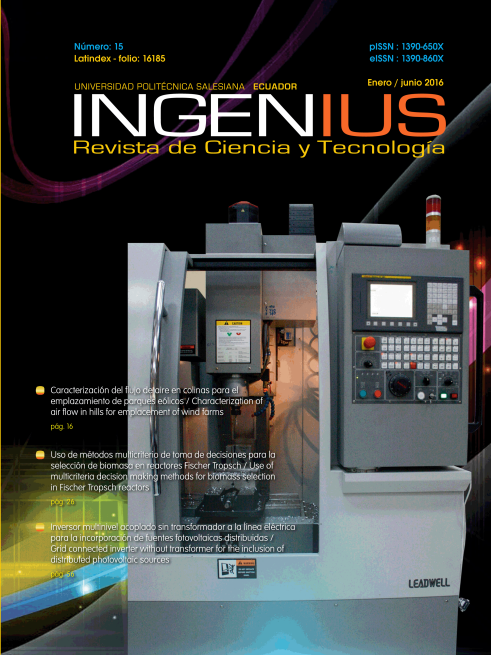Identificación y control CPG de un motor de CA con DSPACE.
Contenido principal del artículo
Resumen
Detalles del artículo
La Universidad Politécnica Salesiana de Ecuador conserva los derechos patrimoniales (copyright) de las obras publicadas y favorecerá la reutilización de las mismas. Las obras se publican en la edición electrónica de la revista bajo una licencia Creative Commons Reconocimiento / No Comercial-Sin Obra Derivada 4.0 Ecuador: se pueden copiar, usar, difundir, transmitir y exponer públicamente.
El autor/es abajo firmante transfiere parcialmente los derechos de propiedad (copyright) del presente trabajo a la Universidad Politécnica Salesiana del Ecuador, para las ediciones impresas.
Se declara además haber respetado los principios éticos de investigación y estar libre de cualquier conflicto de intereses.
El autor/es certifican que este trabajo no ha sido publicado, ni está en vías de consideración para su publicación en ninguna otra revista u obra editorial.
El autor/es se responsabilizan de su contenido y de haber contribuido a la concepción, diseño y realización del trabajo, análisis e interpretación de datos, y de haber participado en la redacción del texto y sus revisiones, así como en la aprobación de la versión que finalmente se remite en adjunto.
Referencias
[2] T. Wildi, “Three-Phase Induction Motors”, in Electrical Machines, Drives, and Power Systems, 5th ed., Ed. New Jersey: Prentice Hall, 2002, pp. 263-298.
[3] P.C. Krause, O. Wasynczuk, S.D. Sudhoff, “Induction Motor Drives”, in Analysis of Electric Machinery and Drive Systems, 2nd ed., Ed. New York: Wiley Interscience, 2002, pp. 525-556.
[4] A. Trzynadlowski, “Construction and Steady-State Operaton of Induction Motors”, in Control of Induction Motors, Ed. San Diego: Academic Press, 2001, pp. 15-42.
[5] Z. A. Ghani, M. A. Hannan and A. Mohamed, “Simulation model of three-phase inverter using dSPACE platform for PV application,” International Review on Modelling and Simulation (I.RE.MO.S.), vol. 5, pp. 137-145, 2012.
[6] P. M. Menghal and A. J. Laxmi, “Real time control of electrical machine and drives: A review,” International Journal of Advances in Engineering & Technology vol. 1, pp. 112-126, 2011.
[7] S. Sztendel, C. Pislaru, A. P. Longstaff, S. Fletcher and A. Myers, “Five-Axis Machine Tool Condition Monitoring Using dSPACE Real-Time System”, 25th COMADEM, Huddersfield, United Kingdom, 2012.
[8] T. S. Giam, K. K. Tan and S. Huang, “Precision coordinated control of multi-axis gantry stages”, ISA Transactions, vol. 46, pp. 399-409.
[9] T. Gallah, R. Trabelsi, R. Abdelati, A. Ben Ali and A. Khedher, “dSPACE DS-1104 implementation of Field Oriented Control for induction motor”, 10th STA , Hammamet, Tunisia, 2009.
[10] J. Jona, Y. Chintu, K. Sri Gowri and G. Kumaraswamy, “Implementation of dSPACE controlled DPWM based induction motor drive”, Proc. IJRET, vol. 2, pp. 448-453, 2013.
[11] J. Versele, O. Deblecker and J. Lobry, “Implementation of Induction Motor Drive Control Schemes in MATLAB/Simulink/dSPACE Envionment for Educational Purpose” [online] Available: http://www.intechopen.com/books/matlab-for-engineers-applications-in-control-electrical-engineering-it-and-robotics/implementation-of-induction-motor-drive-control-schemes-in-matlab-simulink-dspace-environment-for-ed.
[12] M. A. Hannan, Z. A. Ghani and A. Mohamed, “An enhanced inverter controller for PV applications using the dSPACE platform”, International Journal of Photoenergy, vol. 2010, 10 pages, 2010.
[13] M. Jemli, H. B. Azza and M. Gossa, “Real-time implementation of IRFOC for single-phase induction motor drive using dSpace DS 1104 control board,” Simulation Modelling Practice and Theory, vol 17, pp. 1071-1080.
[14] A. Soria, R. Garrido, I. Vásquez and R. Vásquez. “Architecture for rapid prototyping of visual controllers. Robot Auton Syst” [online]. Robotics and Autonomous Systems, vol. 54, pp. 486-495. Available: http://www.sciencedirect.com/science/article/pii/S0921889006000121.
[15] dSPACE Catalog 2014, dSPACE GmbH., Paderborn, Germany, 2014.
[16] ControlDesk Experiment Guide, dSPACE GmbH, Paderborn, Germany, 2008.
[17] D. W. Clarke, C. Mohtadi and P. S. Tuffs, “Generalized predictive control – Part I. The basic algorithm,” Automatica, vol. 23, pp. 137–148, 1987.

